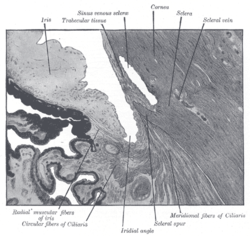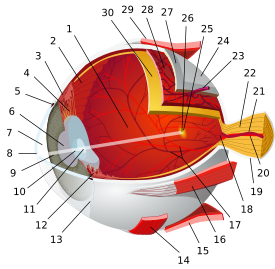- Trabecular meshwork
-
Trabecular meshwork 
Enlarged general view of the iridial angle. (When enlarged, visible with older label of 'trabecular tissue') Latin reticulum trabeculare sclerae Gray's subject #225 1006 MeSH Trabecular+Meshwork The trabecular meshwork is an area of tissue in the eye located around the base of the cornea, near the ciliary body, and is responsible for draining the aqueous humor from the eye via the anterior chamber (the chamber on the front of the eye covered by the cornea).
The tissue is spongy and lined by trabeculocytes; it allows fluid to drain into a set of tubes called Schlemm's canal flowing into the blood system.
Contents
Parts
The meshwork is divided up into three parts, with characteristically different ultrastructures:
- Inner uveal meshwork - Closest to the anterior chamber angle, contains thin cord-like trabeculae, orientated predominantly in a radial fashion, enclosing trabeculae spaces larger than the corneoscleral meshwork.
- Corneoscleral meshwork - Contains a large amount of elastin, arranged as a series of thin, flat, perforated sheets arranged in a laminar pattern; considered the ciliary muscle tendon.[1]
- Juxtacanalicular tissue (also known as the cribriform meshwork) - Lies immediately adjacent to Schlemm's canal, composed of connective tissue ground substance full of glycoaminoglycans and glycoproteins. This thin strip of tissue is covered by a monolayer of endothelial cells.
The trabecular meshwork is assisted to a small degree in the drainage of aqueous humour by a second outflow pathway, the uveo-scleral pathway (5-10% of outflow occurs this way). The uveo-scleral pathway is increased with the use of glaucoma drugs such as prostaglandins (e.g., Xalatan, Travatan).
Role in Glaucoma
Glaucoma is thought to be caused by an increase in intraocular pressure. Pressure increases either when too much aqueous humor fluid is produced or by decreased aqueous humor outflow. The Trabecular meshwork is responsible for most of the outflow of aqueous humor.
See also
References
- ^ Sampaolesi R, Sampaolesi JR, Zárate G (2009). "Ocular Embryology with Special Reference to Chamber Angle Development" (chapter 8). The Glaucomas - Pediatric Glaucomas (volume 1). Springer Berlin Heidelberg. pp. 61-69. ISBN 978-3-540-69146-4. http://www.springerlink.com/content/rkp83w0822835376/
External links
- Histology at BU 08005loa
- trabecular+reticulum at eMedicine Dictionary
- Diagram at glaucoma-association.com
Sensory system – visual system – globe of eye (TA A15.2.1–6, TH 3.11.08.0-5, GA 10.1005) Fibrous tunic (outer) Episcleral layer • Schlemm's canal • Trabecular meshworkUvea/vascular tunic (middle) Retina (inner) LayersCellsPhotoreceptor cells (Cone cell, Rod cell) → (Horizontal cell) → Bipolar cell → (Amacrine cell) → Retina ganglion cell (Midget cell, Parasol cell, Bistratified cell, Giant retina ganglion cells, Photosensitive ganglion cell) → Diencephalon: P cell, M cell, K cell
Muller gliaOtherAnterior segment Posterior segment Other M: EYE
anat(g/a/p)/phys/devp/prot
noco/cong/tumr, epon
proc, drug(S1A/1E/1F/1L)
Categories:- Eye anatomy
Wikimedia Foundation. 2010.


